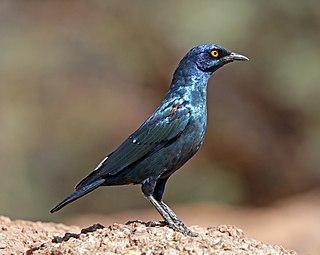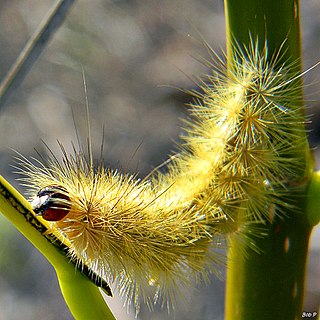
The phainopepla or northern phainopepla is the most northerly representative of the mainly tropical Central American family Ptiliogonatidae, the silky flycatchers. Its name is from the Greek phain pepla meaning "shining robe" in reference to the male's plumage.

The Cape starling, red-shouldered glossy-starling or Cape glossy starling is a species of starling in the family Sturnidae. It is found in Southern Africa, where it lives in woodlands, bushveld and in suburbs.

Lymire is a genus of tiger moths in the family Erebidae. The genus was erected by Francis Walker in 1854.

Polia bombycina is a moth of the family Noctuidae. It is found in the Palearctic realm from Ireland to Japan including the Russian Far East and Siberia.

Chrysoesthia sexguttella, common name the orache leafminer moth, is a moth in the family Gelechiidae. It is found in all of Europe, east to southern Siberia, as well as the north-eastern parts of North America, where it might be an introduced species.

Alexgeorgea is a genus of three plant species found in Western Australia belonging to the family Restionaceae named in honour of the botanist Alex George in 1976. The flowers of the female and large nut-like fruit are completely underground except for the stigmas, which extend out of the ground as 3 purple or red threads.
Phyllonorycter rhynchosiae is a moth of the family Gracillariidae. It is known from South Africa. The habitat consists of the urban hills of Pretoria.

Rhodoneura is a genus of moths of the family Thyrididae described by Achille Guenée in 1858.
Lymire albipedalis is a moth of the subfamily Arctiinae. It was described by Max Gaede in 1926. It is found in Puerto Rico.
Lymire candida is a moth of the subfamily Arctiinae. It was described by William Trowbridge Merrifield Forbes in 1917. It is found on Jamaica and Hispaniola.
Lymire fulvicollis is a moth of the subfamily Arctiinae. It was described by Paul Dognin in 1914. It is found in French Guiana.
Lymire lacina is a moth of the subfamily Arctiinae. It was described by Schaus in 1924. It is found on Cuba.
Lymire methyalea is a moth of the subfamily Arctiinae. It was described by Paul Dognin in 1916. It is found in Peru.
Lymire senescens is a moth of the subfamily Arctiinae. It was described by William Trowbridge Merrifield Forbes in 1917. It is found in Puerto Rico.
Lymire vedada is a moth of the subfamily Arctiinae. It was described by Schaus in 1938. It is found on Cuba.
Tigrioides nitens is a moth in the family Erebidae. It was described by Francis Walker in 1865. It is found in Australia, where it has been recorded from New South Wales, the Northern Territory and Queensland.
The Euchromiina are a subtribe of tiger moths in the family Erebidae. It was described by Arthur Gardiner Butler in 1876. Many species in the subtribe are mimics of wasps.
Anaphes nitens is a species of fairyfly, a chalcid wasp in the family Mymaridae. Native to Australia, it is an egg parasitoid of the gum tree snout beetle, a pest of Eucalyptus trees, and has been used in biological pest control of that species.
Cerconota nitens is a moth in the family Depressariidae. It was described by Arthur Gardiner Butler in 1877. It is found in Brazil (Amazonas).





